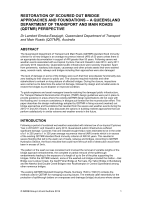Bridges

Restoration of Scoured Out Bridge Approaches and Foundations: A Queensland Department of Transport and Main Roads Perspective
- Publication no: ABC-SAS202-14
- Published: 22 October 2014
- PDF (free) Download
The Queensland Department of Transport and Main Roads (QDTMR) standard flood immunity criterion for all new bridges is an average recurrence interval (ARI) of 50 years unless there is appropriate documentation in support of ARI greater than 50 years. Following severe wet weather events associated with ex-tropical Cyclone Yasi and Oswald in late 2010/early 2011 and early 2013 respectively, Queensland public infrastructure was severely impacted. Apart from pavements, roadway side slopes, causeways and other private assets that were washed away, several roads, railways and bridges including their approaches were also damaged.The level of damage on some of the bridges was such that their post-disaster functionality was zero leading to their closure to public use. The closures required motorists and other stakeholders to embark on long detours of affected bridges. During the closure, inspections were carried out to determine the extent of damage, followed by design and remedial works to restore the bridges to pre-disaster or improved condition.To guide engineers and asset managers towards restoring the damaged public infrastructure, the Transport Network Reconstruction Program design guidelines were put in place to provide guidance in areas where the existing QDTMR design specifications did not cope with the flooding and to ensure consistency in designs put forward for the reconstruction effort. This paper describes the design methodology adopted by QDTMR in fixing scoured (washed out) bridge approaches and foundations that resulted from the severe wet weather events during the 2010/11 and 2013 floods. It also discusses the options in building resilient approaches that can perform satisfactorily in similar extreme wet weather events in the future.
Related publications
ABC2022-112-22
ABC2022-013-22
Latest Bridges News
